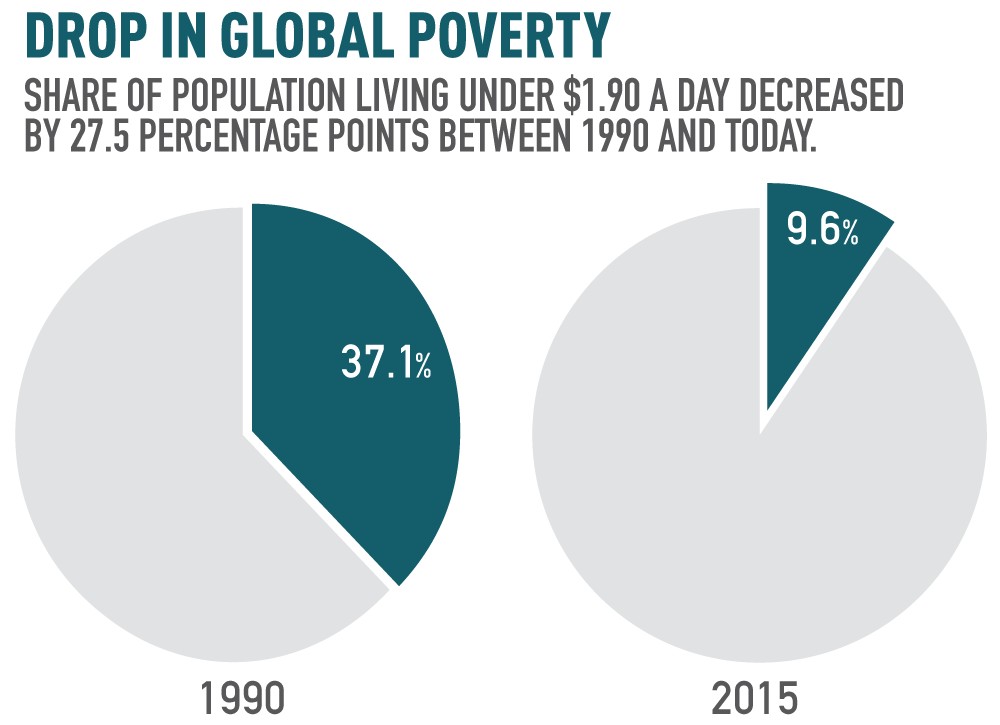Less than 10 percent of the world’s population lives in extreme poverty, new data from the World Bank shows. This marks the lowest that rate has ever been.
Using a baseline of $1.90 a day, the Bank estimates 702 million people will be living in extreme poverty in 2015, down from 902 million in 2012. That’s 9.6 percent of the world’s population, down from 12.8 percent three years ago.
In 1990, nearly 2 billion people lived in extreme poverty: more than a third of the global population.
“This is the best story in the world today — these projections show us that we are the first generation in human history that can end extreme poverty,” World Bank President Jim Yong Kim said. “This new forecast of poverty falling into the single digits should give us new momentum and help us focus even more clearly on the most effective strategies to end extreme poverty. It will be extraordinarily hard, especially in a period of slower global growth, volatile financial markets, conflicts, high youth unemployment, and the growing impact of climate change. But it remains within our grasp, as long as our high aspirations are matched by country-led plans that help the still millions of people living in extreme poverty.”
The region with the most dramatic change in poverty rates was East Asia and Pacific, which dropped more than 93 percent from 60.8 percent of its population in poverty in 1990 to just 4.1 percent in 2015. Europe and Central Asia have mostly stayed consistently in the low single-digit percentages. Sub Saharan Africa dropped by a little more than a third, from 56 percent in 1990 to 35.2 percent in 2015.
In 1990, more than half the world’s extremely poor lived in East Asia and the Pacific region, and 14.5 percent were in Sub Saharan Africa. But today that’s switched: half the world’s poor live in Sub Saharan African countries, while 11.7 percent are in East Asia and Pacific countries.
“Development has been robust over the last two decades but the protracted global slowdown since the financial crisis of 2008, is beginning to cast its shadow on emerging economies,”” said World Bank Chief Economist Kaushik Basu, a former Chief Economic Adviser to the Indian Government in a World Bank release. “There is some turbulence ahead. The economic growth outlook is less impressive for emerging economies in the near future, which will create new challenges in the fight to end poverty and attend to the needs of the vulnerable, especially those living at the bottom 40 percent of their societies.”

You will find more statistics at Statista
 CGTN America
CGTN America
 The son of a street vender, left, sits by a tray of quail-eggs as his sister writes in an exercise-book at a sidewalk in Yangon, Myanmar, Monday, Sept. 28, 2015. According to the UNDP, one in four people in Myanmar lives below the national poverty line and two in five children below the age of five are under-nourished. (AP Photo/Gemunu Amarasinghe)
The son of a street vender, left, sits by a tray of quail-eggs as his sister writes in an exercise-book at a sidewalk in Yangon, Myanmar, Monday, Sept. 28, 2015. According to the UNDP, one in four people in Myanmar lives below the national poverty line and two in five children below the age of five are under-nourished. (AP Photo/Gemunu Amarasinghe)

